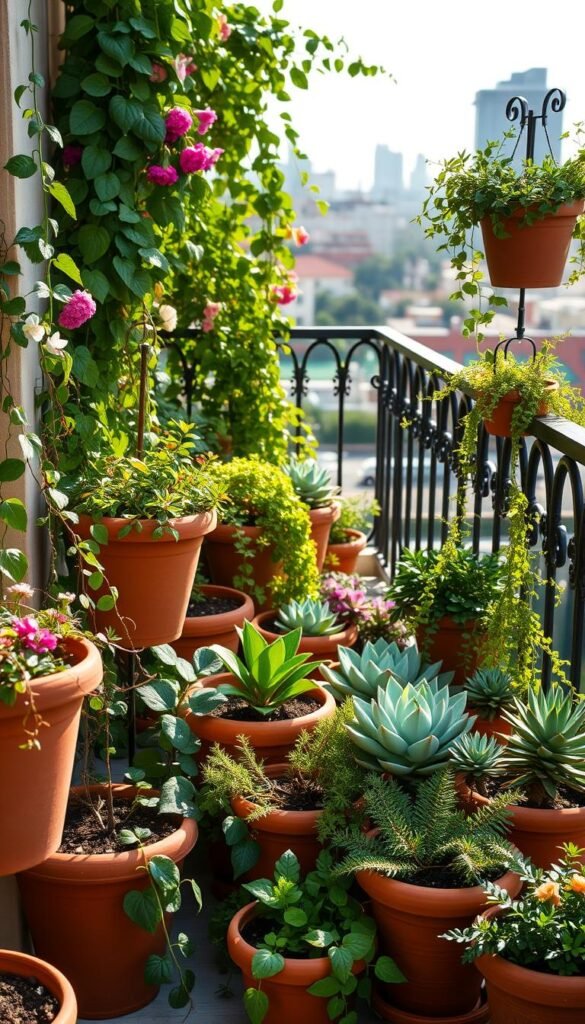Who says you need a backyard to enjoy fresh greenery? Your elevated nook can become a thriving retreat with smart design choices. Even compact areas offer opportunities to grow herbs, flowers, and foliage when you embrace flexible growing methods.
This guide walks through every step – from selecting pots that fit your railings to pairing textures for visual depth. You’ll learn how to work with sunlight patterns and maximize vertical space. Whether you’re nurturing herbs for cooking or vibrant flowers, we’ve got practical tips to help.
Urban living often means adapting to unique conditions. Wind exposure, limited floor space, and varying light levels all shape your plant choices. But here’s the best part: lightweight fabric grow bags, repurposed jars, and stackable planters let you experiment without permanent changes.
We’ll explore how to mix trailing vines with bold statement plants for dynamic arrangements. Discover low-maintenance varieties that thrive in confined settings while adding color and life. Ready to reimagine your slice of the sky? Let’s dig in!
Transforming Your Balcony into a Garden Oasis
City living doesn’t mean sacrificing your green thumb dreams. Your elevated outdoor space can become a serene retreat by blending smart design with playful experimentation. Start by imagining how you want to use this area—whether as a morning coffee spot, an herb haven, or a leafy escape from urban noise.
Setting the Stage for Your Green Retreat
First, measure your space and note sunlight patterns. South-facing spots get intense light, while north-facing areas suit shade-loving plants. Use foldable furniture or wall-mounted shelves to keep floors clear. Railings are prime real estate—try hanging baskets or clamp-on planters for herbs like basil or mint.
Playful Design Meets Practical Solutions
Mix textures and heights to create depth. Pair spiky succulents with trailing ivy, or add pops of color using petunias in recycled tin cans. Vertical gardening tools like pocket planters or bamboo trellises maximize every inch. Urban growers love combining edible greens like kale with fragrant lavender for dual-purpose beauty.
Always check building rules about weight limits or hanging items. Lightweight fiberglass pots and fabric grow bags reduce strain on structures. Remember: your garden should reflect your style—there’s no wrong way to grow joy in small spaces.
Planning Your Dream Container Garden
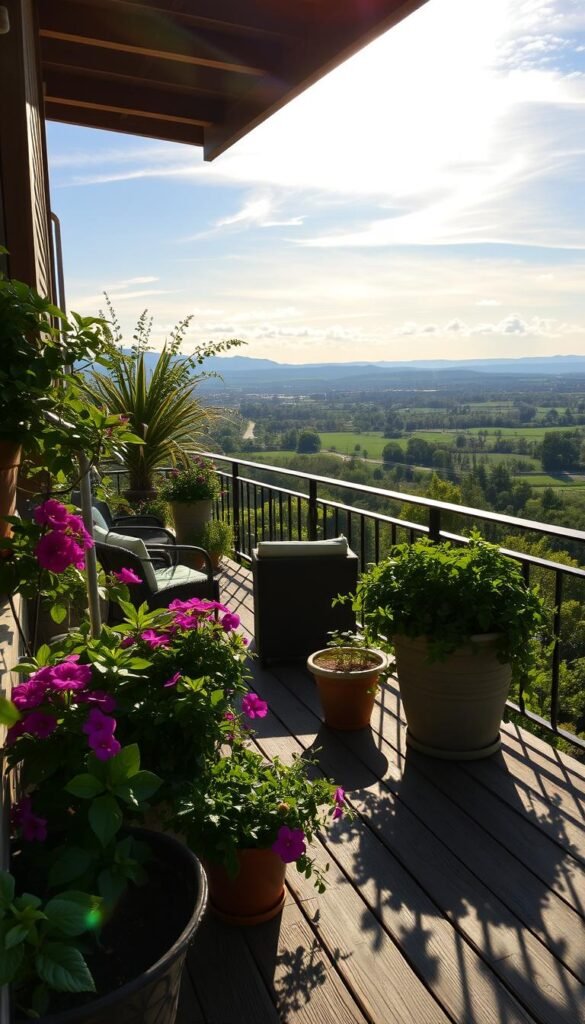
Your outdoor nook holds endless potential—if you map it out thoughtfully. Start by sketching a rough layout of your area. Measure railings, floors, and walls to understand how much room you have. This step ensures every planter has a purpose.
Assessing Your Space and Light Conditions
Sunlight dictates what plants will thrive. Track how light moves across your area over a day. South-facing spots get intense sun—perfect for tomatoes or rosemary. Shady corners? Try leafy greens like spinach or peace lilies.
Mix decorative blooms with edible garden staples. Place taller planters at the back and cascading varieties near edges. Use vertical stands or wall pockets to free up floor space. A 3-tier shelf can hold herbs, flowers, and small veggies without crowding.
| Light Condition | Best Plant Types | Placement Tips |
|---|---|---|
| Full Sun (6+ hours) | Succulents, peppers, marigolds | Railing planters or south-facing walls |
| Partial Shade | Ferns, mint, begonias | Under overhangs or east-facing corners |
| Low Light | Snake plants, parsley, pothos | Wall-mounted pots near reflective surfaces |
No nearby water source? Opt for self-watering pots or add hydrogel crystals to soil. These practical tips for outdoor setups keep roots hydrated between visits. Your dream garden isn’t just pretty—it’s built to work with your life.
Maximizing Vertical Space on Your Balcony
Elevate your green dreams by looking up—your walls and railings hold untapped potential. Vertical gardening lets you grow lush foliage, herbs, and blooms without sacrificing precious floor space. This approach turns overlooked surfaces into living art while keeping your setup organized and airy.
Using Walls, Railings, and Overhead Structures
Start by securing lightweight planters to walls with waterproof adhesive hooks or floating shelves. Metal tension rods across railings can support hanging pots of strawberries or trailing nasturtiums. For climbing plants like peas or jasmine, attach chicken wire panels to create instant trellises.
Overhead beams or retractable clotheslines offer spots for macramé hangers or cascading ferns. Always test railing strength before adding multiple containers—reinforce wobbly sections with brackets. Rotate plants seasonally to refresh your display and ensure even sun exposure.
Mix functional and decorative elements: stack modular planters for herbs, or arrange geometric wall pockets with colorful succulents. These setups keep walkways clear while doubling as natural privacy screens. With smart vertical gardening, even the tiniest balcony becomes a thriving oasis.
Understanding Your Balcony’s Restrictions
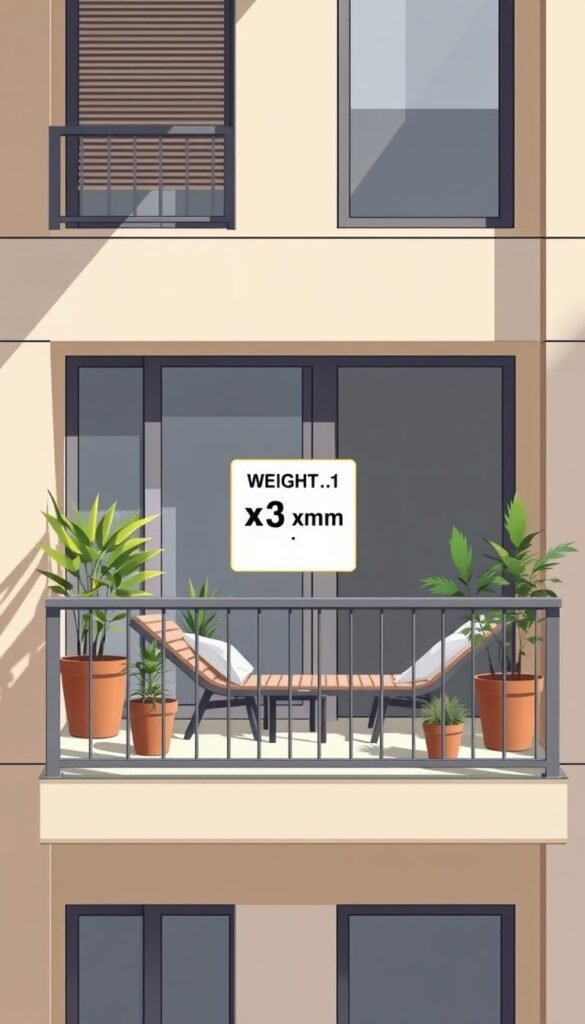
What’s stopping your elevated oasis from thriving? Structural limits and local rules shape how you design your green retreat. Before picking pots or plants, take time to understand your space’s unique challenges.
Weight, Wind, and Local Regulations
Check with your building manager about weight limits—many apartments restrict balcony loads to 50 pounds per square foot. Wet soil adds bulk fast: a 24-inch ceramic planter can weigh over 100 pounds when watered. Opt for lightweight materials like fiberglass or fabric pots instead.
Wind amplifies risks in high-rise settings. Secure containers with bungee cords or non-slip mats. Place heavier items near walls where support beams strengthen the structure. Plastic planters work better in breezy spots than breakable terra-cotta.
| Material | Weight (24″ pot) | Wind Safety |
|---|---|---|
| Plastic | 15 lbs | High |
| Fiberglass | 20 lbs | Medium |
| Ceramic | 45 lbs | Low |
Local codes might ban hanging items over railings or require fire-resistant plants. Your microclimate matters too—wind tunnels dry soil quickly, while shaded corners stay damp. Match plant choices to these conditions for better survival rates.
Safety first: reinforce shelves anchoring vertical gardens and avoid overcrowding. A compliant, well-planned setup keeps your garden thriving without risking damage or fines.
Selecting Durable and Stylish Containers
The right pots do more than hold soil—they elevate your space while supporting healthy growth. Let’s explore materials that balance practicality with personality.
Plastic containers are budget-friendly and lightweight, ideal for windy spots. They resist cracking but may fade over time. Fiberglass planters mimic stone or metal textures without the weight, perfect for modern designs. Fabric grow bags promote air circulation for roots but dry out faster—great for herbs like thyme.
Prioritize weather-resistant options with drainage holes. Self-watering systems save time, while handles make rearranging easy. Match colors to your decor: earthy tones blend naturally, while bold hues add focal points.
- Repurpose wooden crates for rustic charm
- Paint metal tins to complement flowering plants
- Use hanging colanders for strawberries
Your choices shape both aesthetics and plant health. A well-designed container becomes part of the garden itself, merging beauty with purpose.
Choosing the Right Plants for Apartment Gardening

Small-space growers know that success starts with smart plant picks. Focus on varieties that thrive in tight quarters while delivering visual charm or fresh flavors. Let’s explore how to curate your green collection for maximum impact.
Herbs, Vegetables, and Edible Flowers
Compact plants rule in urban settings. Basil and cilantro work beautifully in 8-inch pots, while dwarf tomatoes yield pint-sized harvests. Edible blooms like nasturtiums add peppery zest to salads while brightening your space.
Consider these crowd-pleasers:
- Leafy greens (kale, spinach) for fast-growing texture
- Scallions and radishes with shallow root systems
- Thyme and oregano—drought-tolerant flavor boosters
| Plant Type | Top Picks | Care Tip |
|---|---|---|
| Herbs | Lemon balm, chives | Trim weekly to encourage bushiness |
| Vegetables | Patio peppers, baby carrots | Use deep pots for root development |
| Flowers | Calendula, pansies | Deadhead spent blooms regularly |
Mix feathery dill with bold purple basil for contrast. Pair trailing strawberries with upright lavender in shared planters. Always check mature sizes—a zucchini plant needs four times the space of bush beans.
Your microclimate matters. South-facing spots? Try sun-loving rosemary. Shady corners? Opt for mint or parsley. Rotate seasonal stars like pansies in spring and chrysanthemums in fall. Remember: your plant palette should evolve with your tastes and conditions.
Balcony Transformation: Simple Container Gardening Ideas for Apartments
Your elevated space can burst with life using clever, space-smart strategies. Forget traditional pots—think outside the box with unexpected vessels and vibrant pairings. Whether you’re working with a fire escape-sized area or a wraparound ledge, creative garden ideas turn limitations into opportunities.
Mix materials for visual punch: pair glossy ceramic planters with weathered wooden crates. Paint thrifted tin buckets in sunset hues to complement marigolds or petunias. Upcycled items add character—try growing succulents in colanders or herbs in retro watering cans. These ideas prove style doesn’t require big budgets.
Three DIY projects to spark inspiration:
- Turn vintage drawers into tiered plant stations
- Hang mason jar terrariums from overhead beams
- Convert ladder shelves into vertical herb displays
Rotate plants like trailing ivy and compact cherry tomatoes seasonally. Cluster varying heights for depth—place tall grasses behind low-growing thyme. Even a 4-foot-wide area feels lush when every inch works double duty.
Ready to refresh your setup? Swap out two containers monthly or introduce new textures through woven baskets. The best garden evolves with your tastes. Up next: discover how edible blooms and fragrant herbs elevate your urban oasis.
Incorporating Edible and Fragrant Flower Gardens
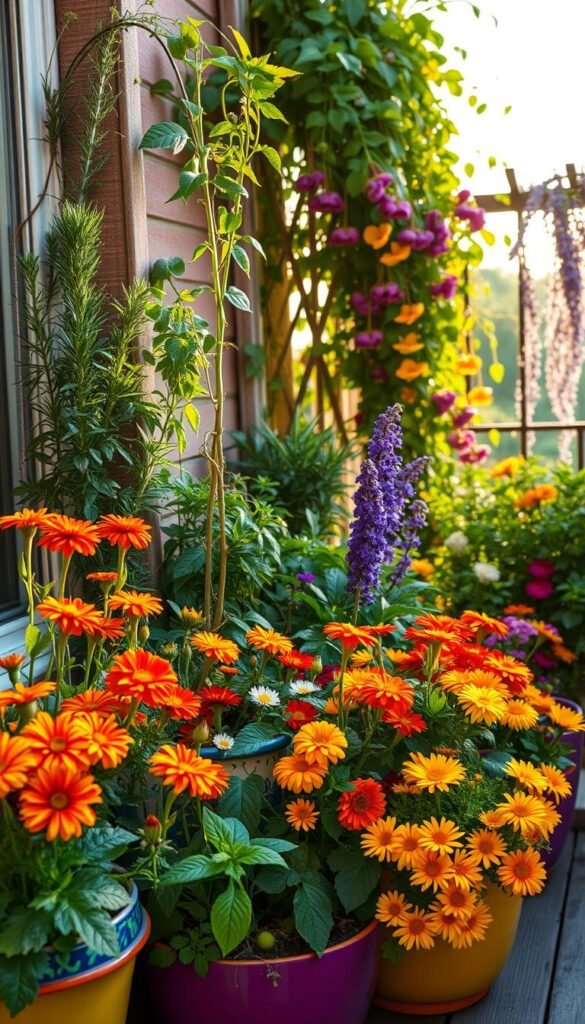
Turn your elevated nook into a feast for the senses by blending tasty blooms with fresh veggies. Edible flowers like nasturtiums and pansies add peppery zing to salads while releasing sweet scents into the air. Pair them with compact vegetable varieties—think cherry tomatoes or dwarf peppers—for a mix that’s as pretty as it is productive.
Create visual harmony by alternating colors and textures. Plant purple basil beside sunny marigolds, or let trailing peas climb a trellis behind low-growing thyme. Use shallow-rooted blooms like calendula to fill gaps between leafy greens. This approach maximizes every inch while keeping your garden both functional and photo-worthy.
Protect delicate petals from harsh conditions. Shield wind-sensitive varieties with taller plants or attach transparent mesh screens to railings. Water early in the day to prevent midday heat stress, and mulch soil to retain moisture. Even a 3-foot ledge can host a vibrant display—try stacking strawberry jars with violas for edible layers.
Don’t shy away from bold experiments. Combine citrus-scented geraniums with mint in shared planters, or tuck chamomile between patio cucumbers. Your balcony becomes a living pantry where beauty and flavor grow side by side. Remember: the best edible garden evolves with your curiosity, one delicious bloom at a time.
Diverse Planter Ideas: From Hanging to Window Boxes
Unleash your creativity by reimagining everyday items as homes for your plants. Your elevated space thrives when you mix functional planters with eye-catching displays. Let’s explore how to turn ordinary objects into extraordinary growing stations.
Creative DIY and Upcycling Techniques
Start with what you already own. Old wooden crates become rustic herb stations when lined with burlap. Mount a repurposed bookshelf horizontally on walls for cascading blooms. Even colanders or teapots can host succulents—drill drainage holes and add personality.
Hanging baskets are space-saving heroes. Suspend them from ceiling hooks or railing brackets to free up floor area. Try these ideas:
- Weave macramé hangers for trailing ivy or strawberries
- Convert wire baskets into air plant displays
- Paint thrifted shutters as vertical stands for small pots
Arrange plant stands at varying heights to create depth. Cluster window boxes with herbs like basil alongside pansies for color contrast. Pair tall ceramic pots with low wooden troughs to guide the eye upward.
| Planter Type | Best Uses | DIY Tip |
|---|---|---|
| Hanging Baskets | Trailing plants, herbs | Line with coconut coir for moisture retention |
| Window Boxes | Compact veggies, flowers | Use L-brackets for secure installation |
| Upcycled Items | Succulents, air plants | Seal porous materials with waterproof paint |
This flexible way of gardening lets you adapt as your needs change. Rotate seasonal compact veggies in modular containers or swap out decor accents. Your garden becomes a living collage of textures and functions.
Using Mini Greenhouses and Hydroponic Systems
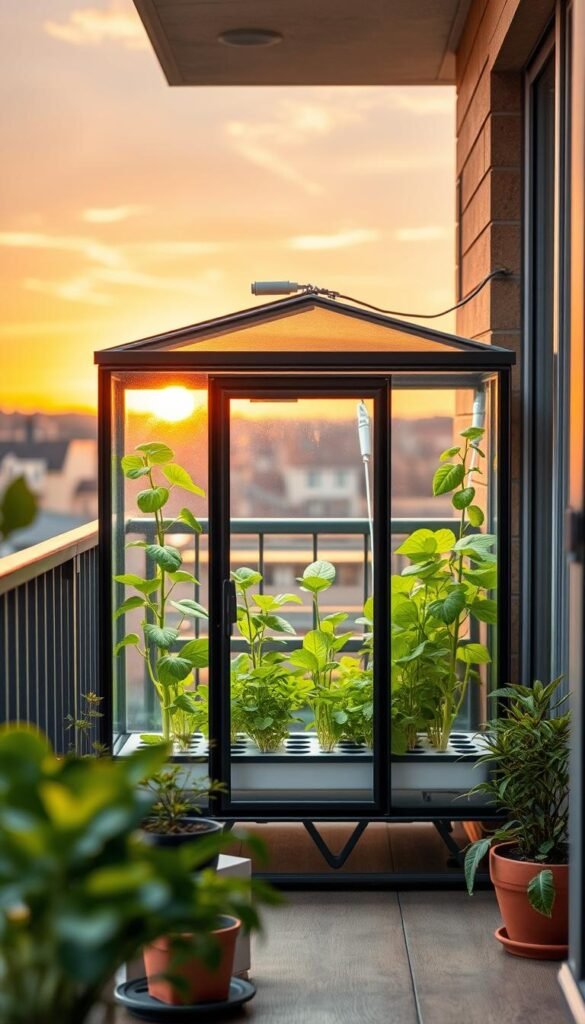
Imagine harvesting fresh herbs in January from your own compact setup. Mini greenhouses and hydroponic systems let you grow greenery year-round, even when frost nips at your windows. These tools create controlled environments where plants thrive without soil or traditional pots.
A mini greenhouse traps warmth and humidity, protecting delicate seedlings from harsh weather. Hydroponics uses nutrient-rich water instead of dirt—perfect for tight spaces. Together, they boost productivity by up to 30% compared to standard methods.
| System | Best For | Space Needed |
|---|---|---|
| Mini Greenhouse | Leafy greens, herbs | 2 sq ft |
| Hydroponic Kit | Tomatoes, peppers | 1 sq ft |
| AquaPots® | Root vegetables | 18″ diameter |
Start simple: use self-watering pots with built-in reservoirs or DIY hydroponics with PVC pipes. Place systems near sunny windows or under grow lights. Timed irrigation tools automate hydration, saving you daily checks.
Urban gardening gets smarter with these tips. Compact units like the AquaPots® Vertical Stack fit snugly on railings, producing basil and strawberries in sync. Your balcony becomes a four-season garden, yielding crisp greens while neighbors scrape ice off their cars.
High-tech doesn’t mean high effort. These solutions simplify water management and pest control. Whether you’re battling limited light or chilly nights, your balcony stays lush and productive—no backyard required.
Vertical Gardening Techniques to Save Space
Why let walls go to waste when they can host your next garden project? Vertical designs turn unused surfaces into thriving plant zones while keeping floors clear. Narrow containers are key—they hug walls and railings, leaving room for seating or decor.
Choose tall, slim pots for herbs like rosemary or mint. These containers cast smaller shadows, letting sunlight reach lower plants. Stagger shelves or racks to create tiers—place sun-loving varieties higher up and shade-tolerant greens below.
Three tips for layered growth:
- Use wall-mounted pockets for strawberries or trailing petunias
- Install adjustable hooks to rotate plants with changing light
- Combine vertical stands with floor pots for depth
Hanging planters add movement and maximize air flow. Suspend them from ceiling rods or railing brackets—just ensure they’re lightweight. Rotate arrangements seasonally to maintain even growth patterns.
Smart layouts trick the eye into perceiving more space. Alternate textures between smooth metal planters and woven baskets. Add mirrors behind shelves to reflect light and greenery, doubling visual impact without crowding.
Your elevated area becomes a living tapestry when walls work as hard as your floors. Start small: one vertical planter today could inspire a full green wall tomorrow.
Enhancing Your Balcony with Railing and Hanging Planters
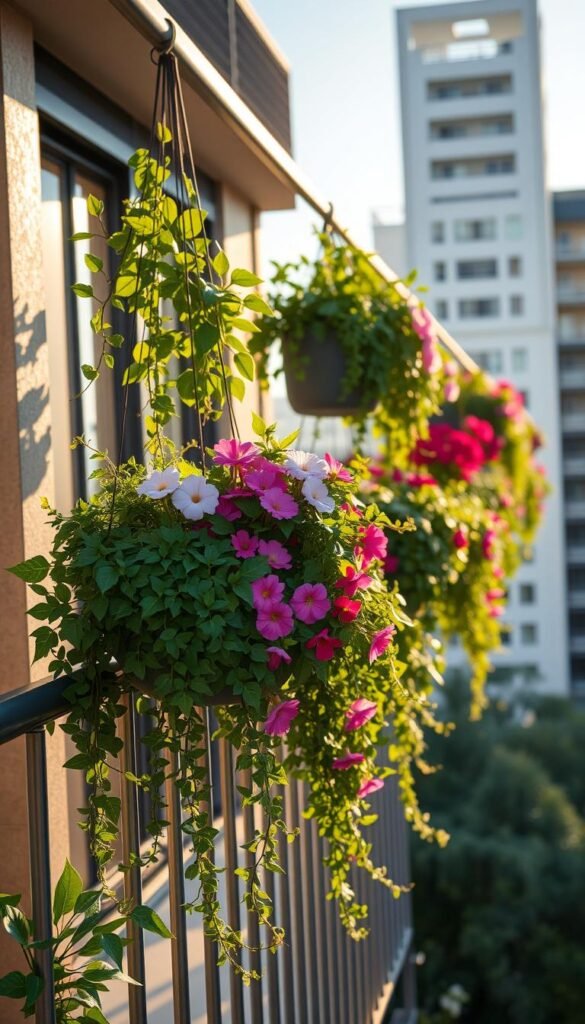
Turn overlooked edges into lush displays with smart planter placements. Railings and overhead spaces offer prime spots to grow herbs, flowers, and trailing vines without cluttering your floor. This approach adds depth while keeping pathways clear for relaxation or entertaining.
Secure installation matters most. Use adjustable brackets or clamp-on systems designed for your railing type. For heavier pots, add silicone pads to prevent slipping. Test stability by gently shaking containers after mounting—they shouldn’t wobble.
Mix materials for visual interest. Pair sleek metal boxes with woven baskets, or hang repurposed colanders bursting with petunias. Train climbing plants like jasmine on mini trellises attached to railings. These setups create living curtains that soften urban views.
| Planter Type | Best Plants | Installation Tip |
|---|---|---|
| Railing Boxes | Herbs, lettuce | Use L-brackets every 12 inches |
| Hanging Baskets | Fuchsias, strawberries | Secure with carabiners |
| Wall-Mounted | Succulents, air plants | Check wall anchors weekly |
Seattle resident Mia Chen transformed her 40-square-foot space using tiered planters. She grows thyme in railing troughs and lets cherry tomatoes cascade from hanging pots. “Layering plants at different heights makes the area feel larger,” she notes.
Always prioritize safety. Avoid overloading railings—distribute weight evenly across multiple brackets. For renters, removable adhesive hooks let you create stunning displays without permanent changes. Your elevated garden becomes a dynamic showcase that evolves with the seasons.
Effective Watering and Care Tips for Container Plants
Keep your plants thriving, not just surviving, with smart hydration strategies. Urban growers face unique challenges—intense sun, drying winds, and limited time. But the right tools and routines ensure your green friends stay lush without constant babysitting.
Smart Hydration Made Simple
Self-watering pots are game-changers for busy lifestyles. Their built-in reservoirs supply moisture for 3-7 days, preventing root rot from overwatering. Pair them with lightweight hoses or collapsible cans for quick top-ups. These tools save space and reduce spills on tight balconies.
Wind and heat accelerate drying. Check soil daily during heatwaves by sticking your finger an inch deep. Add saucers under pots to catch runoff—this recycled water helps during dry spells. Group plants with similar needs together to streamline care.
Three essentials for stress-free maintenance:
- Expandable hoses that coil neatly after use
- Terracotta spikes for gradual drip irrigation
- Moisture meters to eliminate guesswork
Morning watering reduces evaporation and fungal risks. Adjust frequency as seasons shift—plants drink less in cooler months. With these tips, even weekend travelers can maintain vibrant displays. Your garden becomes resilient, adapting to your schedule while staying photo-ready.
Designing a Cohesive Look with Color and Texture

Your outdoor space becomes a living masterpiece when colors and textures harmonize. Think of it as curating an art gallery—every pot, plant, and accessory should feel intentional. A unified garden design ties your elevated retreat to your indoor style, creating flow between spaces.
Start by choosing a color palette that complements your home’s exterior or favorite room. Soft whites and lavender pair well with modern gray furniture, while terra-cotta pots pop against navy walls. Mix leaf shapes for contrast: spiky yucca beside round hydrangeas adds instant drama.
Three strategies to unify varied planters:
- Paint mismatched containers the same muted green
- Repeat geometric patterns in woven baskets and ceramic pots
- Use trailing ivy to visually connect stacked shelves
Edibles and ornamentals can coexist beautifully. Pair purple basil with pansies in shared window boxes, or let rosemary spill over a planter’s edge near dwarf sunflowers. One New Yorker transformed her 50-square-foot area by mirroring her kitchen’s sage-and-cream tones in cushions and glazed pots.
Balance bold ideas with restraint. A single red chair amid neutral planters becomes a focal point, not chaos. Rotate seasonal accents—swap pumpkin-colored mums for icy cyclamen—while keeping base elements consistent. Your designs should feel curated, not cluttered.
Remember: cohesion isn’t about perfection. It’s creating a space where every choice feels like it belongs. Whether you lean toward wild cottage charm or sleek minimalism, let your personality guide the mix.
Practical Safety and Stability Considerations
Your sky-high garden should be as secure as it is beautiful. Overlooking structural limits could turn your lush retreat into a hazard. Let’s explore how to balance aesthetics with smart safety practices.
Managing Weight and Securing Containers
Start by calculating your setup’s total load. A 20-inch container filled with wet soil can weigh 50+ pounds. Multiply this by several pots, and you risk exceeding weight limits. Use lightweight materials like fiberglass or foam planters for heavy-duty structures.
Anchor large pots with these methods:
- Bungee cords looped around railings
- L-brackets bolted to walls
- Non-slip rubber mats under ceramic planters
| Anchoring Method | Best For | Materials Needed |
|---|---|---|
| Wall Brackets | Vertical gardens | Stainless steel screws, drill |
| Straps | Hanging baskets | Nylon webbing, carabiners |
| Adhesive Pads | Lightweight pots | Waterproof mounting tape |
Check local building codes before installing trellises or privacy screens. Some cities restrict heights or materials. For windy conditions, group containers near walls where support beams add stability.
Inspect mounts monthly for rust or loosening. Replace worn straps immediately. Pair safety checks with watering routines—it takes seconds to ensure everything stays firmly in place. Your privacy screens and planters last longer when properly secured.
Wrapping Up Your Balcony Garden Journey
Your journey from concrete corners to lush retreats proves that greenery thrives where passion meets planning. Whether you’ve tucked fragrant herbs into wall pockets or trained peas up trellises, every choice reflects your unique vision. Remember: even a modest setup yields fresh flavors and daily joy.
Mix textures and functions for maximum impact. Pair spiky succulents with velvety basil, or let cherry tomatoes cascade beside marigolds. Plant stands and vertical layers turn cramped areas into dynamic displays, while smart watering routines keep leaves perky.
Safety and creativity go hand in hand. Secure pots against wind, rotate sun-loving plants, and share surplus harvests with neighbors. Your elevated oasis becomes an extension of your home—a place to sip coffee surrounded by mint’s aroma or unwind under twinkling lights.
Ready to grow? Start small, experiment often, and celebrate each sprout. Connect with fellow urban growers to swap tips and snap photos of thriving vegetables. Every planter you nurture transforms not just your space, but how you experience city living.

